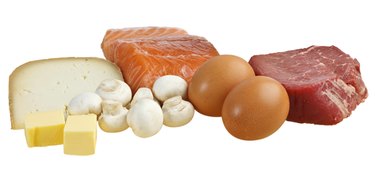
Vitamin D is an essential nutrient that helps you build your teeth and bones and also helps your body use calcium. You make some of this vitamin in your body, but it also comes from food sources such as fish oil, as well as animal sources such as the waxy substance called lanolin. Vitamin D from lanolin goes through an extensive chemical process, but doesn't act any differently in your body than vitamin D from fish oil.
Fish Oil
Video of the Day
Fish liver oils and the flesh of high-fat fish such as tuna and salmon are among the few foods that naturally contain significant amounts of vitamin D. Cod liver oil, in particular, contains a high amount of the vitamin when compared to other food sources such as eggs, beef liver and milk. Besides milk, other forms of dairy only contain large amounts of vitamin D if they're fortified with synthetic forms of the vitamin. Other commonly fortified products include orange juice, margarine and cereal.
Video of the Day
Lanolin Processing
Lanolin is derived from wool-bearing animals like sheep. To get vitamin D from lanolin, supplement manufacturers first purify it and crystallize it, then put it through a chemical process that produces a substance called 7-dehydrocholesterol. The 7-dehydrocholesterol is then liquefied in an organic solvent and exposed to ultraviolet radiation. These chemical changes turn 7-dehydrocholesterol into a substance called vitamin D-3. Next, supplement manufacturers further purify and crystallize this vitamin and add it to their products.
Same Body Effects
When scientists create vitamin D from lanolin with the help of ultraviolet radiation, they partially mimic the natural process in your body that produces vitamin D when you expose your skin to sunlight. Both processes produce vitamin D-3, and fish oil also contains this form of the vitamin. Both synthesized D-3 and D-3 from food act the same way in your body, according to the National Institutes of Health's Office of Dietary Supplements. They also have slight chemical differences from another form of the vitamin called vitamin D-2, which comes from plants or plant-based sources.
Considerations
Most people get enough vitamin D from about 10 minutes of sun exposure to avoid any deficiencies. Still, you can develop a deficiency if you have obesity, have dark skin, don't get regular sun exposure, consume low amounts of vitamin D-containing foods for extended periods, have problems absorbing the vitamin from your digestive tract or have kidney damage that disrupts normal vitamin D processing. Because you produce vitamin D naturally, doctors can sometimes have problems determining appropriate supplemental doses. Potential consequences of taking too much of the vitamin include unwanted weight loss, heartbeat irregularities and damage to your heart, kidneys or blood vessels. If you have questions or concerns, review your vitamin D intake with your doctor.